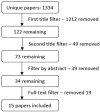Are multi-cat homes more stressful? A critical review of the evidence associated with cat group size and wellbeing
- PMID: 34037488
- PMCID: PMC8807997
- DOI: 10.1177/1098612X211013741
Are multi-cat homes more stressful? A critical review of the evidence associated with cat group size and wellbeing
Abstract
Objectives: The primary objective of this review was to conduct a systematic critical appraisal of published literature, in order to assess the evidence regarding the impact of cat group size on cat wellbeing in the domestic home. The secondary objectives were to: (i) identify additional social and environmental mediators of cat wellbeing in these contexts; and (ii) identify general limitations within the current evidence and provide recommendations for future studies.
Methods: A systematic search of electronic databases (Scopus, Web of Science and Google Scholar) was conducted using targeted Boolean phrasing. Papers were retained for appraisal of full text where they included a comparison of both single (n = 1) and multi-cat (n ⩾2) domestic housing conditions and/or comparison of different multi-cat group sizes, within a single study, and where they compared outcome measures that were either behavioural and/or physiological and deemed as relevant indicators of cat wellbeing.
Results: A total of 1334 unique papers were returned, 15 of which were retained. Of these papers, only four stated their primary aim to be an investigation of links between cat group size and cat wellbeing. Overall, the reviewed papers did not indicate consistent directions of effects regarding cat group size and outcome measures relevant to wellbeing. This was similar for the other social and environmental mediators identified.
Conclusions and relevance: Inconsistency in results is likely due to the substantial methodological variation, limitations in measures used as indicators of wellbeing and limitations in general study designs and reporting. Results also highlight the complex, multifactorial relationships between cat wellbeing and various social and environmental factors. These may be as, if not more, important than absolute numbers of cats residing within a household. Due to the various limitations and general paucity of research, further studies are recommended to provide a suitable evidence base regarding impacts of multi-cat living on cat wellbeing in domestic environments.
Keywords: Felis silvestris; Household; conflict; health; welfare.
Conflict of interest statement
The authors declared no potential conflicts of interest with respect to the research, authorship, and/or publication of this article
Figures
Similar articles
-
Conspecific and Human Sociality in the Domestic Cat: Consideration of Proximate Mechanisms, Human Selection and Implications for Cat Welfare.Animals (Basel). 2022 Jan 25;12(3):298. doi: 10.3390/ani12030298. Animals (Basel). 2022. PMID: 35158622 Free PMC article. Review.
-
A critically appraised topic (CAT) to compare the effects of single and multi-cat housing on physiological and behavioural measures of stress in domestic cats in confined environments.BMC Vet Res. 2014 Mar 22;10:73. doi: 10.1186/1746-6148-10-73. BMC Vet Res. 2014. PMID: 24655603 Free PMC article. Review.
-
Beyond the black stump: rapid reviews of health research issues affecting regional, rural and remote Australia.Med J Aust. 2020 Dec;213 Suppl 11:S3-S32.e1. doi: 10.5694/mja2.50881. Med J Aust. 2020. PMID: 33314144
-
Environmental Aspects of Domestic Cat Care and Management: Implications for Cat Welfare.ScientificWorldJournal. 2016;2016:6296315. doi: 10.1155/2016/6296315. Epub 2016 Sep 28. ScientificWorldJournal. 2016. PMID: 27774506 Free PMC article. Review.
-
Small class sizes for improving student achievement in primary and secondary schools: a systematic review.Campbell Syst Rev. 2018 Oct 11;14(1):1-107. doi: 10.4073/csr.2018.10. eCollection 2018. Campbell Syst Rev. 2018. PMID: 37131395 Free PMC article.
Cited by
-
CATastrophic myths part 1: Common misconceptions about the social behavior of domestic cats and implications for their health, welfare, and management.Vet J. 2023 Oct-Dec;300-302:106028. doi: 10.1016/j.tvjl.2023.106028. Epub 2023 Sep 6. Vet J. 2023. PMID: 37683761 Free PMC article. Review.
-
Why can't we be friends? Exploring factors associated with cat owners' perceptions of the cat-cat relationship in two-cat households.Front Vet Sci. 2023 Mar 27;10:1128757. doi: 10.3389/fvets.2023.1128757. eCollection 2023. Front Vet Sci. 2023. PMID: 37051515 Free PMC article.
-
Stress and the domestic cat: have humans accidentally created an animal mimic of neurodegeneration?Front Neurol. 2024 Jul 19;15:1429184. doi: 10.3389/fneur.2024.1429184. eCollection 2024. Front Neurol. 2024. PMID: 39099784 Free PMC article. Review.
-
Conspecific and Human Sociality in the Domestic Cat: Consideration of Proximate Mechanisms, Human Selection and Implications for Cat Welfare.Animals (Basel). 2022 Jan 25;12(3):298. doi: 10.3390/ani12030298. Animals (Basel). 2022. PMID: 35158622 Free PMC article. Review.
-
Home Sweet Home: The Impact of Lifestyle on a Cat's Approach to Impossible Tasks in the Home Environment.Animals (Basel). 2023 Aug 20;13(16):2679. doi: 10.3390/ani13162679. Animals (Basel). 2023. PMID: 37627470 Free PMC article.
References
-
- Calhoon RE, Haspel C. Urban cat populations compared by season, subhabitat and supplemental feeding. J Anim Ecol 1989; 58: 321–328.
-
- Heidenberger E. Housing conditions and behavioural problems of indoor cats as assessed by their owners. Appl Anim Behav Sci 1997; 52: 345–364.
-
- McCobb EC, Patronek GJ, Marder A, et al.. Assessment of stress levels among cats in four animal shelters. J Am Vet Med Assoc 2005; 226: 548–555. - PubMed
-
- Natoli E, De Vito E. Agonistic behaviour, dominance rank and copulatory success in a large multi-male feral cat, Felis catus L., Colony in central Rome. Anim Behav 1991; 42: 227–241.
-
- Mertens C. Human-cat interactions in the home setting. Anthrozoös 1991; 4: 214–231.
Publication types
MeSH terms
LinkOut - more resources
Full Text Sources
Other Literature Sources
Miscellaneous


